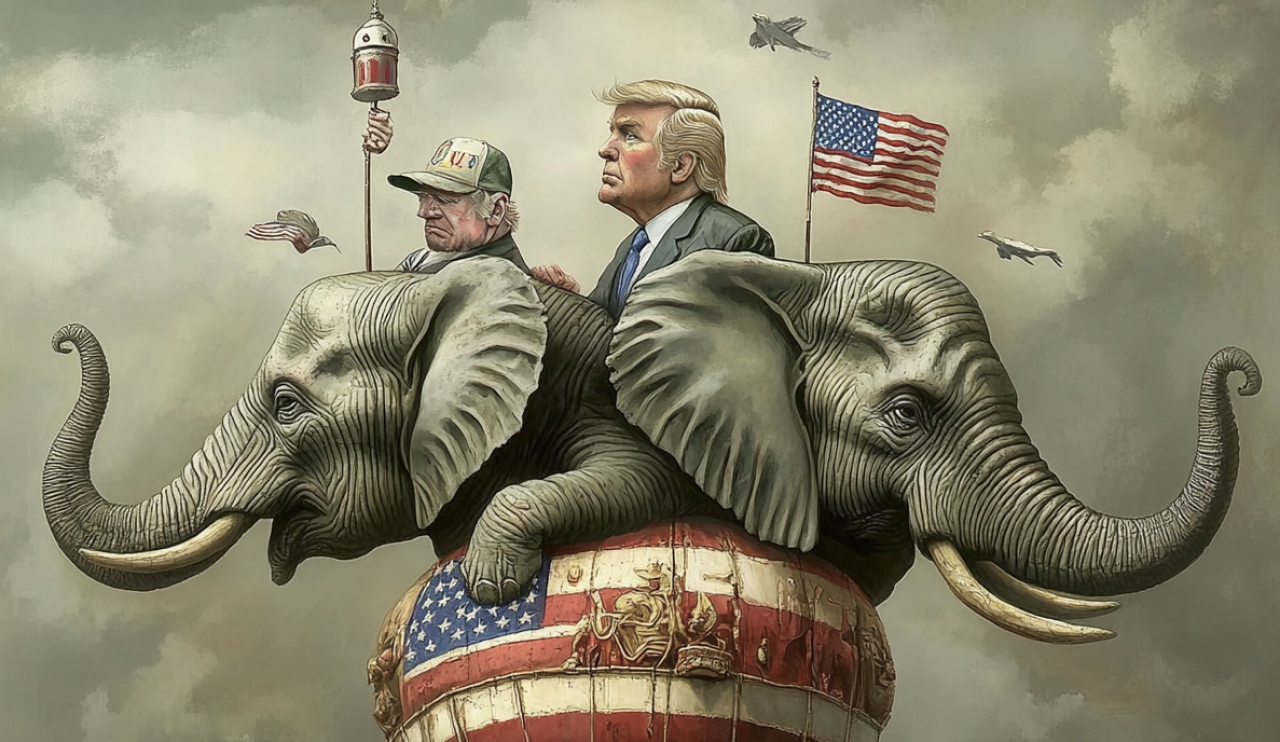by Alexander Dugin 17-09-2024

Alexander Dugin applies Lacan’s three orders to US politics, arguing that while Kamala Harris and the Democrats seek to dismantle traditional structures, “psychedelic Trumpism,” influenced by figures like Curtis Yarvin, Peter Thiel, and J. D. Vance, alongside the Alt-Right, counters from the right, with a warning that a Harris victory could spell the end of humanity.
Lacan’s Method
Let us try to apply Lacan’s topology to the American elections.
Let us recall Lacan’s basic model. It can be represented as three Borromean rings or three orders:
- The Real
- The Symbolic
- The Imaginary
The Real is the domain where every object is strictly identical to itself. This absolute identity (A=A) excludes the very possibility of becoming, i.e., of being in a state of transformation. Thus, the Real is the zone of pure death and nothingness. There are no changes, movements, or relations. The Real is true, like the truth of nothingness that has no alternatives.
The Symbolic is the domain where nothing equals itself, where one thing always refers to another. It is an escape from the Real, motivated by the desire to avoid death and falling into nothingness. It is here that content, relationships, movements, and transformations are born, but always in a dreamlike state. The Symbolic is the unconscious. The essence of a symbol is that it points to something other than itself (it does not matter what specifically, as long as it is not itself).
The Imaginary is the domain where the dynamic of the Symbolic stops, but without the object dying and collapsing into the Real. The Imaginary is what we mistakenly take for Being, the world, ourselves — nature, society, culture, and politics. It is everything, yet it is also a lie. Every element of the Imaginary is actually a frozen moment of the Symbolic. Wakefulness is a form of sleep that does not realize itself. Everything in the Imaginary refers to the Symbolic but presents itself as supposedly “Real.”
In the Real, A=A is true. In the Imaginary, A=A is false. In the Imaginary, no object is identical to itself, but unlike in the Symbolic, it doesn’t want to admit this — neither to itself nor to others.
The Real is nothing. The Symbolic is ever-changing becoming. The Imaginary consists of false nodes of the frozen Symbolic.
Lacan and Politics
Lacan was well aware that the model of the three orders casts doubt on the basic strategies of reformism, progressivism, and revolution. It is no coincidence that in his youth, he was right-wing and a monarchist, close to Charles Maurras. And in the 1960s, contrary to the “New Left,” he supported the status quo and de Gaulle’s rule. This was no accident but stems directly from the Borromean rings model.
The “New Left” revolutionaries (in Lacan’s interpretation) wanted to replace the Imaginary (old social-political structures, order as such) with the Symbolic (surreal, schizophrenic, transgressive). They used Lacan’s ideas in a utilitarian way — ironic Freudianism helped undermine the claims of the Imaginary (Order) to foundational logic (A=A), revealing it as merely a frozen moment of delirium. However, they overlooked the fact that once the old Imaginary collapses or melts under the pressure of critique (whether political, aesthetic, social, or epistemological), the Symbolic cannot take its place. It will instantly become the new Imaginary — equally totalitarian, dictatorial, and absurd.
Examples of this, Lacan saw everywhere, especially in Soviet Bolshevism. The Bolsheviks began with a call for freedom and equality but quickly transformed into a rigid party hierarchy with a totalitarian apparatus of violence. The same happened with Cromwell or the French Revolution. The Symbolic retains its properties only while remaining in the unconscious, in the realm of dreams. The moment it surfaces, it turns into the Imaginary, essentially the same thing, though now dressed in new forms. All Imaginary systems were once Symbolic, alive, and changing before freezing into permanence.
Thus, today’s revolutionary is tomorrow’s totalitarian, cruel official and enforcer of violence. Reforms (in the context of the Borromean rings) are impossible, as they will lead to the same result. The Symbolic can never replace the Imaginary under any conditions.
Lacan believed this, and this conclusion flows directly from his system.
Kamala Harris and the Symbolic
Now to the US elections. Here we see a fierce clash between “progressives” (Kamala Harris, the Democratic Party) and “conservatives” (Trump and the Republicans). In Lacanian analysis, the roles seem obvious: Kamala Harris embodies an invitation to transgression, the legalization of perversions, and liberation from all prohibitions and norms, i.e., the expansion of the Symbolic realm. The Democrats’ platform is a structure of well-tempered delirium: more LGBT, more cancel culture, more illegal immigrants, more drugs and gender reassignment surgeries, more deconstruction of old orders, more BLM and critical race theory.
Of course, the main Imaginary being mocked and attacked from all sides is Donald Trump — the generalized archetype of “unfreedom,” “hierarchies,” and “male rationality.”
Kamala Harris represents the Symbolic, as seen in her strange speeches, endless cold and meaningless laughter, her incoherence, and her expressive gestures that point to something intuitively understandable but indefinable. Harris is a figure of active dreaming. The voter sees in her that the impossible becomes possible, and one thing seamlessly flows into another. But everything remains unfocused and blurry. This is “progress”: Whites become Blacks, capitalists become something else (“Loot the stores — that’s the whole law!”), men and women become vague objects of desire (Lacan’s “little a”), always evading fixation.
In other words, despite Lacan’s own warnings about the unchanging structure of the Borromean rings, the Democrats are actively trying to destroy the American Imaginary, fervently wanting to replace it with the Symbolic.

